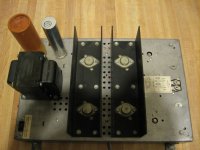I just got a classy looking amp from a friend. It obviously has two blown transistors because the resistors next to them are all burnt out. Anyway, the label on the chassis reads
No. 18300
67095
MODEL DPA150-2
if anyone can identify this amp, please let me know. I would like to get the schematics for it so i can fix it. (It’s hard to read the numbers on the transistors...)
No. 18300
67095
MODEL DPA150-2
if anyone can identify this amp, please let me know. I would like to get the schematics for it so i can fix it. (It’s hard to read the numbers on the transistors...)
i'd just guess...
magnavox
can we see the other side(s)?
http://db.audioasylum.com/cgi/m.mpl?forum=vintage&n=74571&highlight=magnavox&r=&session=
magnavox
can we see the other side(s)?
http://db.audioasylum.com/cgi/m.mpl?forum=vintage&n=74571&highlight=magnavox&r=&session=
I was just given one of these amps. It obviously has a bad filter cap. I wonder if you ever found any information on they device?I just got a classy looking amp from a friend. It obviously has two blown transistors because the resistors next to them are all burnt out. Anyway, the label on the chassis reads
No. 18300
67095
MODEL DPA150-2
if anyone can identify this amp, please let me know. I would like to get the schematics for it so i can fix it. (It’s hard to read the numbers on the transistors...)
Most circuits are generic, based on the output devices.
Start from that.
TO-3, so 3055, or MJ series. Or European equivalents, very rarely Soviet (!).
Voltage will give you further clues.
Measure Hfe, and so on.
Also, check what brand caps are used, their origin will be a further clue. Just might be Japanese.
Not really outstanding, you can use the power supply for another output type, replace with generic transistor boards, or Class D modules.
Repairing old boards made in a small workshop scale factory, with average quality parts is not rewarding, in my opinion.
Start from that.
TO-3, so 3055, or MJ series. Or European equivalents, very rarely Soviet (!).
Voltage will give you further clues.
Measure Hfe, and so on.
Also, check what brand caps are used, their origin will be a further clue. Just might be Japanese.
Not really outstanding, you can use the power supply for another output type, replace with generic transistor boards, or Class D modules.
Repairing old boards made in a small workshop scale factory, with average quality parts is not rewarding, in my opinion.
Last edited:
Looks like it maybe a PA amp, like they where used in schools. airports and other public buildings
- Home
- General Interest
- Everything Else
- Please help identify this amp
